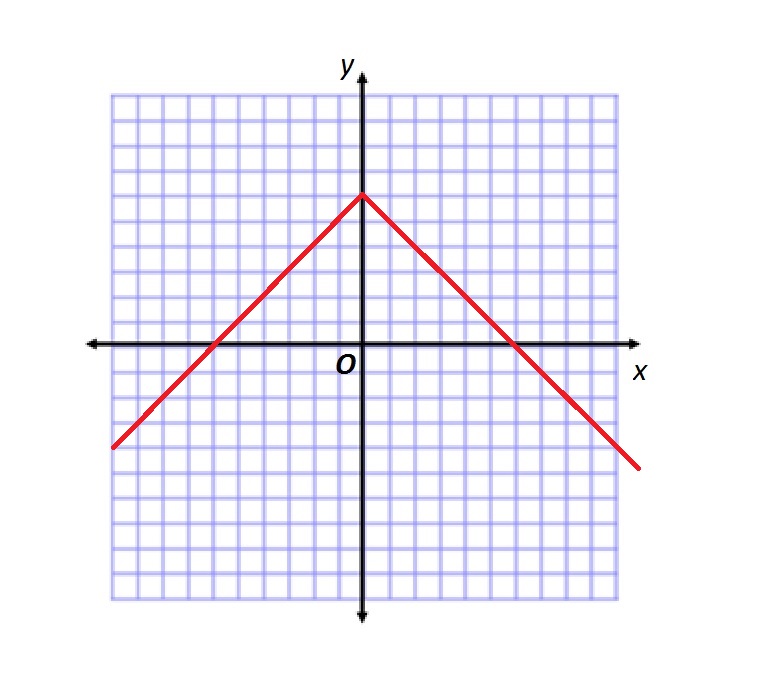All Algebra II Resources
Example Questions
Example Question #71 : Solving Absolute Value Equations
Which values of provide the full solution set for the inequality:
Example Question #1 : Graphing Absolute Value Functions

Refer to the above figure.
Which of the following functions is graphed?
Below is the graph of :

The given graph is the graph of reflected in the -axis, then translated up 6 units. This graph is
, where .
The function graphed is therefore
Example Question #71 : Absolute Value

Refer to the above figure.
Which of the following functions is graphed?
Below is the graph of :

The given graph is the graph of reflected in the -axis, then translated left 2 units (or, equivalently, right units. This graph is
, where .
The function graphed is therefore
Example Question #3 : Graphing Absolute Value Functions

Refer to the above figure.
Which of the following functions is graphed?
The correct answer is not given among the other responses.
Below is the graph of :

The given graph is the graph of translated by moving the graph 7 units left (that is, unit right) and 2 units down (that is, units up)
The function graphed is therefore
where . That is,
Example Question #1 : Graphing Absolute Value Functions

What is the equation of the above function?
The formula of an absolute value function is where m is the slope, a is the horizontal shift and b is the vertical shift. The slope can be found with any two adjacent integer points, e.g. and , and plugging them into the slope formula, , yielding . The vertical and horizontal shifts are determined by where the crux of the absolute value function is. In this case, at , and those are your a and b, respectively.
Example Question #5 : Graphing Absolute Value Functions
Give the vertex of the graph of the function .
None of the other choices gives the correct response.
Let
The graph of this basic absolute value function is a "V"-shaped graph with a vertex at the origin, or the point with coordinates . In terms of ,
The graph of this function can be formed by shifting the graph of left 6 units ( ) and down 7 units (). The vertex is therefore located at .
Example Question #4862 : Algebra Ii
Give the vertex of the graph of the function .
None of the other choices gives the correct response.
Let
The graph of this basic absolute value function is a "V"-shaped graph with a vertex at the origin, or the point with coordinates . In terms of ,
,
or, alternatively written,
The graph of is the same as that of , after it shifts 10 units left ( ), it flips vertically (negative symbol), and it shifts up 10 units (the second ). The flip does not affect the position of the vertex, but the shifts do; the vertex of the graph of is at .
Example Question #82 : Absolute Value
Which of the following absolute value functions is represented by the following graph?
The equation cannot be determined from the graph.
The equation can be determined from the graph by following the rules of transformations; the base equation is:
The graph of this base equation is:
When we compare our graph to the base equation graph, we see that it has been shifted right 3 units, up 1 unit, and our graph has been stretched vertically by a factor of 2. Following the rules of transformations, the equation for our graph is written as:
Example Question #1 : Addition And Subtraction

Above is the menu at a coffee shop.
Jerry has a coupon that entitles him to a free butter croissant with the purchase of one large drink of any kind. The coupon says "limit one per coupon".
He decides to purchase a large espresso, a large cappucino, and two butter croissants. Disregarding tax, how much will he pay for them?
None of the other responses is correct.
The coupon will entitle him to one free croissant, so Jerry will pay for the large espresso, the large cappucino, and one butter croissant. The charge will be the sum of the three prices:
Example Question #2 : Addition And Subtraction
Find the distance, , between point and point .
Use the distance formula to solve this problem.
Plugging in our points A and B we get the following distance.
Certified Tutor
All Algebra II Resources


















































































































